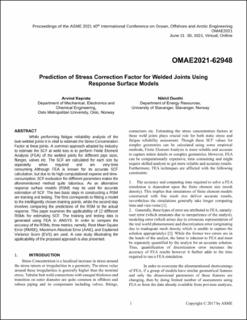Prediction of Stress Correction Factor for Welded Joints Using Response Surface Models
Conference object
Published version
Permanent lenke
https://hdl.handle.net/11250/2988645Utgivelsesdato
2021-10-11Metadata
Vis full innførselSamlinger
Originalversjon
https://doi.org/10.1115/OMAE2021-62948Sammendrag
While performing fatigue reliability analysis of the butt-welded joints it is vital to estimate the Stress Concentration Factor at these joints. A common approach adopted by industry to estimate the SCF at weld toes is to perform Finite Element Analysis (FEA) of the welded joints for different pipe sizes, flanges, valves etc. The SCF are calculated for each size by separately when required and are very time consuming. Although FEA is known for its accurate SCF calculation, but due to its high computational expense and time-consumption, SCF evaluation for different parameters makes the aforementioned method quite laborious. As an alternative response surface models (RSM) may be used for accurate estimation of SCF. The two basic steps in constructing a RSM are training and testing. The first corresponds to fitting a model to the intelligently chosen training points, while the second step involves comparing the predictions of the RSM to the actual response. This paper examines the applicability of 12 different RSMs for estimating SCF. The training and testing data is generated using FEA in ANSYS. In order to compare the accuracy of the RSMs, three metrics, namely, Root Mean Square Error (RMSE), Maximum Absolute Error (AAE), and Explained Variance Score (EVS) are used. A case study illustrating the applicability of the proposed approach is also presented.
